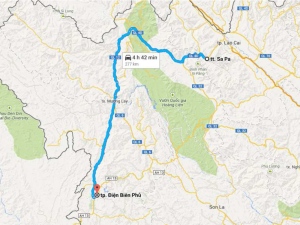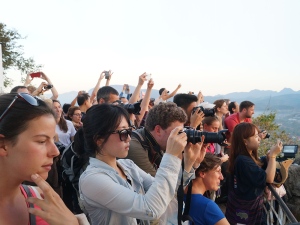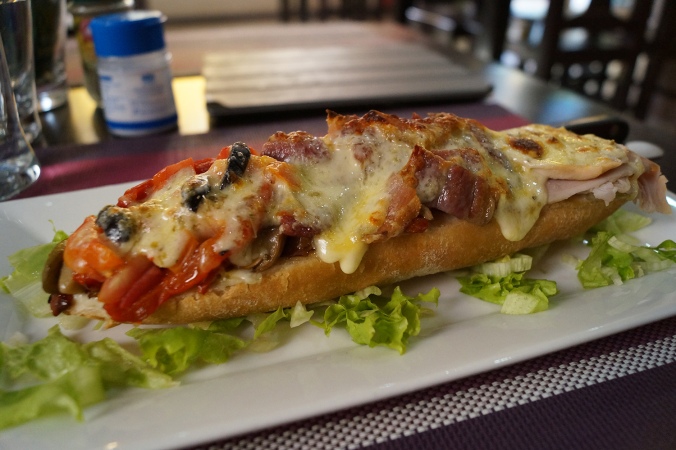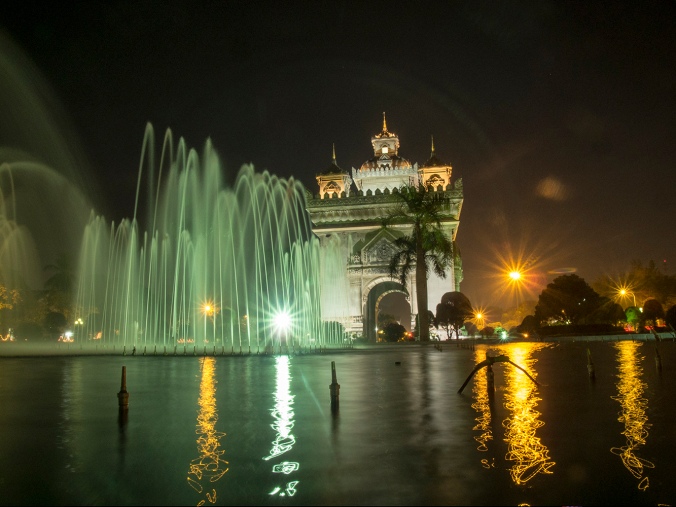After a month spent exploring Hanoi and northern Vietnam, it was time for us to move on. We could have stayed longer in Sapa, walking to villages and mountains beyond the necessarily easily accessed ones of our short stay, just as we could have spent longer walking, climbing and kayaking around Cat Ba, or exploring the secrets down Hanoi alleyways. We could have stayed, but we’d never been to Southeast Asia before; how would we know the treasures we were neglecting unless we journeyed onwards?  So, with Sapa’s hidden gems joining the growing list of “next time” trips, we packed our bags and boarded a bus headed for Điện Biên Phủ. A mere 130km separates these two Vietnamese towns, but the road meanders through some 277km of tight bends, high passes and deep valleys that would take our bus 10 hours to traverse.
So, with Sapa’s hidden gems joining the growing list of “next time” trips, we packed our bags and boarded a bus headed for Điện Biên Phủ. A mere 130km separates these two Vietnamese towns, but the road meanders through some 277km of tight bends, high passes and deep valleys that would take our bus 10 hours to traverse.
We were on a good sleeper bus, not quite as luxuriously appointed as the bus from Hanoi to Sapa but the stacked beds promised a half-decent place to sleep, and ten hours sleep would be be more than enough for someone used to cutting back to four when study demands it. Unfortunately I’m accustomed to keeping late evenings, and rising accordingly. Setting off at 7pm, sleep eluded me for many hours as we dodged and swerved our way through the mountains. When it finally arrived, sleep was not destined to be long-lived. The bus had no toilet, and instead made stops at late-night eateries or quiet stretches of road every few hours. Even when more inclined to curl up beneath a blanket, the light and noise of an entire bus disembarking past my head proved ample distraction to disrupt my already broken sleep. I was put in mind of Starship Troopers, the latest book I’d read from NPR’s list of the top 100 Sci Fi & Fantasy novels, and the line “Happiness consists in getting enough sleep. Just that, nothing more.” Right then, I’d have been ecstatic with nothing more or less than a few hours’ solid sleep.
“Happiness consists in getting enough sleep. Just that, nothing more.“
When we pulled up in Điện Biên Phủ around 5am, I was utterly exhausted, and this was not our destination. We were ushered off the bus and onto a small shuttle bus that (we foolishly believed) was taking us to the nearby border crossing to meet the connecting bus we’d booked. I haven’t had great experiences with buses in Vietnam, and it was telling that only Westerners were boarding this second bus. All the locals, including some we knew to be aimed for the same destination, vanished. They, it turned out, knew the difference between the buses, and not to trust the drivers happy to accept the more expensive ticket on a cheap bus. Our bus was filled behind us as we waited, a solid wall of freight slowly spreading forward from the back row. When it was behind our heads and under our feet, it moved out the windows and spread across the roof. The bus set off at 7am, and stop-started its way between freight pickup points (who knew we still had space?) for an hour until we reached the Vietnam-Laos border 16km away, collected us again on the far side of immigration, and started its delivery run. We were due to arrive in Luang Prabang at 6pm, but that was on the bus we had booked, not the one we’d been loaded onto. This bus took detours, stopping every few kilometres along the already winding indirect road to offload everything from personal parcels to sheets of fibre-cement roofing, replacing them with more cargo bound for destinations vaguely along our route. Sleeping while all this took place around us, and the music blared to keep the drivers awake, was not an option.
At 8pm, about halfway to Luang Prabang, we stopped in a small town for dinner. Our vague plans of exploring the twilit city on arrival had been abandoned and we dug into what turned out to be the best bowl of Phở we’d had so far this trip (strange that it was only after we’d left it’s home country that we found a good example of the dish). There we discovered something about Laos. Kip, the local currency, is worth about 2.5 times the Vietnamese Dong, but ATM fees if you withdraw money and the actual exchange rates you can get put the value at 3 Dong to the Kip. The numbers on menus didn’t reflect this and were the same in Laos as they had been in Vietnam. So everything cost three times as much there as it had in Vietnam (and that wasn’t counting the bribes, which can be sizeable). The bus sped up as it closed on the city, with all the remaining cargo apparently meant for our destination. So it was only 11pm when we were dumped on a random street, far from the bus station, by a driver who refused to point out on our map where we were. We asked another passsenger who’d been left there (a Luang Prabang local), and discovered something else about Laos. They don’t use maps. She was quite capable of using the proffered tablet, but eventually just pointed triumphantly at the name “Luang Prabang” in one corner of the map. Yes, we knew which city we were in. We asked another local at the only shop still open. She, too, used the tablet confidently to scroll and zoom on the map, before declaring “Luang Prabang”. Fortunately, our rambling footsteps soon brought us to a distinctively shaped intersection, enough of a clue to find the suburb in which we’d booked accommodation (they hadn’t been willing to give us more details than that in advance), then a sign pointing toward the guesthouse, and finally to a locked gate that someone thankfully opened soon after we arrived to wheel their motorbike through. Relieved, we collapsed onto something vaguely reminiscent of a mattress. Unfortunately someone had clearly heard that mattresses contain springs, and knew that springs are made of wire. So they had made a grid of widely-spaced wires, covered with a thin sheet. We didn’t even care… much.
There we discovered something about Laos. Kip, the local currency, is worth about 2.5 times the Vietnamese Dong, but ATM fees if you withdraw money and the actual exchange rates you can get put the value at 3 Dong to the Kip. The numbers on menus didn’t reflect this and were the same in Laos as they had been in Vietnam. So everything cost three times as much there as it had in Vietnam (and that wasn’t counting the bribes, which can be sizeable). The bus sped up as it closed on the city, with all the remaining cargo apparently meant for our destination. So it was only 11pm when we were dumped on a random street, far from the bus station, by a driver who refused to point out on our map where we were. We asked another passsenger who’d been left there (a Luang Prabang local), and discovered something else about Laos. They don’t use maps. She was quite capable of using the proffered tablet, but eventually just pointed triumphantly at the name “Luang Prabang” in one corner of the map. Yes, we knew which city we were in. We asked another local at the only shop still open. She, too, used the tablet confidently to scroll and zoom on the map, before declaring “Luang Prabang”. Fortunately, our rambling footsteps soon brought us to a distinctively shaped intersection, enough of a clue to find the suburb in which we’d booked accommodation (they hadn’t been willing to give us more details than that in advance), then a sign pointing toward the guesthouse, and finally to a locked gate that someone thankfully opened soon after we arrived to wheel their motorbike through. Relieved, we collapsed onto something vaguely reminiscent of a mattress. Unfortunately someone had clearly heard that mattresses contain springs, and knew that springs are made of wire. So they had made a grid of widely-spaced wires, covered with a thin sheet. We didn’t even care… much.
Unsurprisingly, there wasn’t a great deal of sleep to be had on our wire torture instrument, since it cut off circulation to whichever parts of the body were touching it. So I failed to regain the lost sleep from the bus before the day’s growing heat forced us out of the stuffy room and onto the streets. The streets of Luang Prabang provided an amazing baguette and some godawful coffee that set us to rights, and we started figuring out what we were going to do with ourselves during our short stay. The Royal Palace Museum was our first stop, and proved worthy of the half-day we spent there. Its architecture was as interesting and spectacular as the numerous temples around it but, after looking at several gold- and red-painted buildings, I found that my sleep deprived mind couldn’t really tell them apart. Only one really stood out, atop the small peak of Phou Si rising from the centre of the city. From the narrow terrace surrounding it, we (and every single one of the other few thousand Westerners visiting the city that day) watched the sun setting over Luang Prabang.  The streets below filled with the nightly handicraft markets, and we meandered our way through them upon our return to ground level. A side-alley provided what would turn out to be our sole cheap meal in Laos, where you pay only 15,000 Kip (2 USD) for a large bowl piled full of all the types of dumplings, noodles, rice and vegetable stirfries you can fit. We also, suckered in by the smell, tried a bag of different kinds of marinated BBQ meat, the small handful of them costing more than the huge bowl. Then, exhausted and looking forward to the more mattress-like mattress in the room we’d changed to that morning, we once again tried for some sleep.
The streets below filled with the nightly handicraft markets, and we meandered our way through them upon our return to ground level. A side-alley provided what would turn out to be our sole cheap meal in Laos, where you pay only 15,000 Kip (2 USD) for a large bowl piled full of all the types of dumplings, noodles, rice and vegetable stirfries you can fit. We also, suckered in by the smell, tried a bag of different kinds of marinated BBQ meat, the small handful of them costing more than the huge bowl. Then, exhausted and looking forward to the more mattress-like mattress in the room we’d changed to that morning, we once again tried for some sleep.
Dawn found us long-gone from our room, to join throngs of others trying to be surreptitious while watching the daily alms giving ceremony. This tradition sees the young Buddhist monks from the temples strewn throughout Luang Prabang taking to the streets each morning. There they accept donations of sticky rice and fruit, some of which is shared with poor children as they walk, and the rest of which makes up their meal for the day. We’d read the strict rules posted in every public building, cafe and tourist guide, on how Westerners were to act while viewing the ceremony. So it was painful to watch how a few of those who watched seemed determined to find ways to disrupt what is a highly sacred ritual. A few people with camera flashes, getting their children to offer a donation just out of reach so that the monks would wait, and standing between the alms givers and the monks for a better view, all detracted from what is otherwise a beautifully symbolic ritual. Somewhat subdued, and still sleep-deprived, we spent the rest of the morning (and there was so much of it left after a ritual that finished before dawn) in the UNESCO listed peninsula of Luang Prabang. The afternoon was spent contemplating a toilet bowl as one of the pieces of BBQ meat from the previous evening had its revenge on me. Jess, unafflicted, spent the rest of her New Year’s Eve studying (unlike me and my undergrad summer freedom, she has only a four week holiday, so has to spend some of her days working as we travel from place to place). My stomach settled enough by day’s end to contemplate a bus to Phonsavan for the following morning, but it did not make for a comfortable night’s sleep.
We had to rise early to catch our bus, the kilometres separating us from the bus station not lying along a normal tuk tuk route. But we made it to the bus, and my stomach wasn’t the one that rebelled as we wove our way south. We had heard (without quite believing) that locals in Vietnam and Laos don’t cope well with buses on winding roads. We’d doubted this, since they have nothing but winding roads, and would surely be used to them. But that bus trip confirmed every story we’d heard. Most people had brought a few bags with them, prepared to spend a few hours being constantly sick (although the driver still had to hose down the side of the bus partway along the journey; presumably someone ran out of bags and used the window). After emptying their stomachs, they would spend ten minutes or so hacking up astounding quantities of follow-up phlegm at incredible volumes. What with the noise and wafting smells, there was to be no catching up on sleep as we wended our way to Phonsavan. Instead, I sincerely hoped, I’d be able to have an early night when we arrived. Pretty much on schedule, we pulled into the bus station and got a minivan the last few kilometres into town. My attempt to eat some local food proved in vain, for my stomach nearly rebelled at every mouthful, so I retired to our guesthouse. We had outdone ourselves with the cheapest accommodation yet this trip (Sabaidee Guesthouse), which had a half-decent bed, and I collapsed for the first semi-solid sleep I’d seen since Vietnam. We would have to get up early for a tour the next day, but that was still hours away.
The Plain of Jars is remarkable for remaining a complete mystery, kept that way by a combination of factors. There is a huge disparity between what little is known about the vast stone urns (carved from everything from limestone to granite, and containing fragments of ancient human remains) and the local oral-traditions about them (fired from mixed salt, sand and leather, and used to distill rice wine), which suggests that the civilization that left them behind had no contact with the ancestors of the current occupants. Archaeological examination of the site didn’t occur until a brief study in the 1930s removed every artefact of significance from where they had been preserved from the elements in a nearby cave, and wasn’t followed up until 1994, after a significant event had taken place. The Plain of Jars was heavily bombed by the United States from 1964 to 1973, as part of their campaign to convince the neutral country of Laos that communism was evil and that they should hate the Vietnamese. The highly suspect logic behind the bombings aside, the area now holds the dubious honour of being the most heavily bombed place in the world. Quite apart from damaging many of the jars, it means that most sites are still inaccessible for researchers, since forty years has only seen seven of the ninety sites successfully cleared of the cluster munitions that failed to detonate on impact. Even at Site 1, the most heavily frequented by tourists, there were clear markers showing where to walk. The 127 pieces of UXO cleared from the site came from small areas around each cluster of jars, connected by narrow pathways. The vast majority of the site remains off-limits.
We stayed only a single day in Phonsavan, realising how little time we had left before we were due back in Australia. We caught an overnight bus to Vientiane the same afternoon we explored the Plain of Jars. Two overnight buses left two hours apart. Not wanting to sit in the bus terminal for two hours, we caught the earlier one. Any regained sleep was lost once more. This sleeper bus was not what we’d hoped for, severely lacking when it came to reclined beds and long stretches of restful silence. Instead, it had hard vertical seats, painfully loud music (I do actually worry for my hearing while taking some of these buses) to keep the driver awake, and stopped every 2-3 minutes from Phonsavan to Vientiane to exchange cargo. Pulling into Vientiane’s bus station at 5am, we snuck through a cracked door into a deserted building to try to catch an hour’s nap in the deserted building. Yes, it was gloomy with only a flickering lightbulb in one corridor for illumination. Yes, there was something alive down one corridor, its snarls interspersed with the sound of something heavy being dragged along the floor. Yes, we suspected we’d get robbed, knifed or eaten by zombies. No, we didn’t care. Alas, our sleep was interrupted not by the groaning creature, but by someone switching on the lights two minutes later. On to the city then, and hope we found a bed early.
Wifi, so abundant and unsecured across Vietnam, is rare and encrypted in Vientiane. So we wandered the city (or 5.6km of it, anyway) until we found a cafe with internet to await word from a Couchsurfer we’d arranged to stay with. There, we discovered a form of happiness that wasn’t sleep, but was instead deliciously decadent Western comfort food. Our chosen cafe’s cheapest (and best, in my opinion) food was a baguette, split lengthways and topped with bacon, caramelised onion, roast vegetables, and lashings of grilled cheese. It wasn’t sleep, but melted cheese kept us going through a day of quiet writing. When we heard from our host, we made at once for his workplace, a French bar we’d checked out several hours before it had opened that morning. Chatting with him before the evening rush began, we discovered the horrors of what the French do to their wine in Laos.
Australian wine ranges from astoundingly good to abominably bad, with only a slight correlation between its price and quality. The Australian wine palette is still developing, and (I had thought) lags behind its French counterpart. The French understand wine. It’s part of their culture. They knew how to serve it. They don’t send bottles of tangy red specially from France to Southeast Asia, store them at 2°C, open them and leave them sitting uncorked for a week while slowly selling them one near-frozen glass at a time. And yet, our expat French bartender served us a glass of icy imported red wine under the supervision of his expat French manager in his French bar aimed at expat Frenchmen. We also tried some of their house red, a South African cask wine rating somewhere below Aussie Sunnyvale (the source of countless adolescent hangovers), that was so cold it hurt my teeth to drink it. Perhaps I’d had the French figured wrong all along.
But if their taste in wine was now under suspicion, it was clear that the expat French living in Vientiane still knew their cheese. Seeing us sitting and drinking wine, one bar patron insisted on sharing some of what turned out to be the standout best camembert I’d ever tasted. Its skin barely stopped the soft, ripe cheese from flowing across the plate. Or maybe that was just the joy of runny cheese again…
From the bar, we made our way to our hosting couchsurfer’s house, a villa that plays constant host to passing tourists in exchange for stories. One such visitor just needed a minute to move some stuff off a spare bed and use the attached shower (rather than one of the house’s other two showers) and we could get our first sleep in two days. Three hours of not-so-subtle hints later, approaching midnight, the lingering happiness of camembert and melted cheese had long-since faded in favour of simmering resentment. Only sleep, when it did finally arrive, could cure all. A fresh day, nearly a week after reaching the country, and we were finally ready to visit Laos.
























Pingback: BBQ Dog—An experience | A Taswegian's tasty adventures